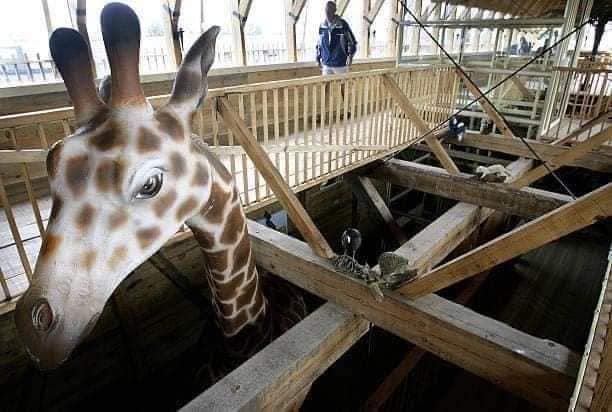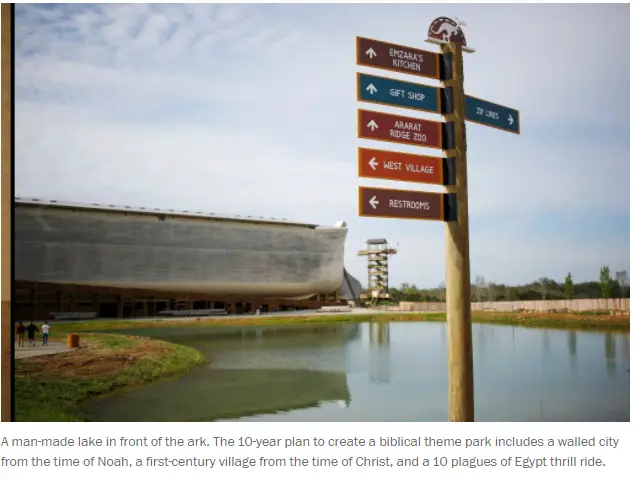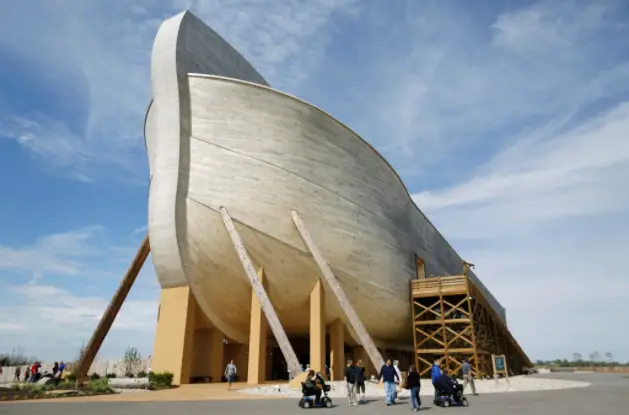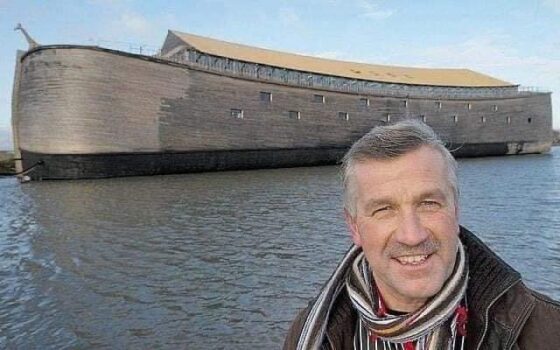Not many people can say they’ve built something extraordinary and unique in their lifetimes. Sure, maybe you built your house, or even a backyard shed! But imagine a full life size Noah’s ark ship. One man had the vision to do so and actually did it.
Ken Ham is one of those people.
It all started in Williamstown, Ky. — Ken Ham built an ark, the size of the actual Noah-sized ark, in the hills of Kentucky.
Once you see this massive wooden vessel, tourists — decidedly more than two-by-two, a caravan of buses surrounding the site — gasp in wonder. Many christian school students storm the ramps, many completing science quizzes based on anti-evolutionary teachings. Admission is $40 for adults, $28 for students, but school groups often pay less with bulk discounts available.
An online and publishing ministry with a creationist interpretation of the Bible, employed around 700 people to build the $120 million Ark Encounter, which is a whopping five stories high and a football field and a half in length! The massive boat was designed by a veteran of amusement park attractions, which also has a commissioned original soundtrack to enhance the experience even further, and stocked the interior with an animatronic (and eerie real) talking Noah, along with lifelike models of Earth’s manifold creatures. Including dinosaurs, which is a bit confusing as it falls in line more with the theory of evolution.
A giant ark is just the start. These creationists have a bigger plan for recruiting new believers.
You can explore the life-size replica of Noah’s Ark and the Creation Museum in Kentucky.
The ark opened last summer and is on target, Ham says, to attract more than a million visitors in the first year. But Ham did not rest on his laurels. Instead he doubled down on it’s success.
The 65-year-old Australian and his partners, Mike Zovath and Mark Looy, have launched an ambitious 10-to-12-year plan to re-create a walled city from the time of Noah and a 1st-century village from the time of Jesus.
Also, a Tower of Babel, concept snack shacks, a 3,200-seat amphitheater and a 10-plagues-of-Egypt thrill ride. This includes concepts from biblical tales such as frogs! hail! locusts and more!
Instead of building a church, the organization Answers in Genesis is sharing its teachings through a controversial biblical theme park designed to attract believers and nonbelievers alike.
“How do you reach the general public in a bigger way?” Ham muses rhetorically, sitting in his expansive corner office at the Creation Museum, his first, more sober foray into the family entertainment business, which celebrates its 10th anniversary on Memorial Day. “Why not attractions that people will come to the way they go to Disney or Universal or the Smithsonian?”
Why not?
Answers in Genesis is certainly adopting a different approach from the Museum of the Bible, which is scheduled to open in November in Washington and aims to attract all religions. AiG wants to attract all tourists and introduce them to its specific brand of faith.
Ham and his partners are creationists and Christian apologists who believe that the Earth is only 6,000 years old. (Contrary to what scientists believe who say that it’s more like 4.5 billion years — or older.) Apologetics is a branch of Christianity whose adherents actively defend their faith, and Ham is a robust debater.
The author or co-author of 50 or 60 books — he’s not sure, a rare instance of uncertainty — he argues that the Bible is a historical narrative and that “the whole gospel message is found in Genesis.” He believes that dinosaurs prowled the planet alongside humans and that the biblical flood created the Grand Canyon. One of his books is titled “The Lie: Evolution.” He maintains that Noah labored seven decades to construct his vessel and was 600 years old when the storm surged. (By comparison, the AiG team took only seven years to build the Kentucky ark.)
Ham — is it coincidence that his name is the same as one of Noah’s sons’? — began his career as, of all things, a science teacher in a tiny Australian town. But as his education continued evolution didn’t sit right with him as the son of parents who subscribed to creationist beliefs.
“I took students to museums and saw that all the museums were totally from an evolutionary perspective,” he says. He began researching the creationist view of science, and ultimately began lecturing on the subject and was invited to speak at the Institute for Creation Research, then based outside San Diego.
He came to the conclusion that America was the best location for getting his message out to the world. “It’s the center of the business world, the center of the Christian world,” he says.
He acknowledges that his views aren’t commonly shared, and he’s fine with that. But will debate you about it if you’re willing to take the challenge.
“Obviously, we’re in a minority,” he says in his pronounced Down Under accent. But “just because a majority believes in something doesn’t mean it’s right. People love darkness rather than light. If a majority believes something, I’m naturally suspicious because of the sin nature of man.”
Ham has twice debated evolution with television science star Bill Nye, at the Creation Museum in 2014 and two years later at the Ark Encounter, events that Answers in Genesis touts as akin to a modern-day Scopes trial — and that Ham believes he won. (Nye declined to comment.)
Ham proudly points out that where many museums and attractions “are reliant on government subsidies or a few large donations,” the ark was funded by 42,000 small donors. “The average donation was $230,” he says, though there were several large gifts. That’s a lot of people dedicated to making this ark happen.
But the project’s single largest source of funding was actually $62 million in junk bonds floated by the town of Willamstown, population less than 4,000, home to the Ark Encounter and the county seat of Grant County, which faced bankruptcy this spring. How about that?
“In terms of revenue for the county, we don’t get too much from them,” says the county’s chief executive, Stephen Wood. The Ark Encounter negotiated a vastly discounted 30-year rate on property taxes in 2013 under a previous administration. “I hate it, but that’s the deal,” says Wood.
Unsurprisingly, the Ark Encounter and Answers in Genesis have attracted a loud chorus of critics who question this financial backing.
“Why would the state indirectly subsidize a nonsensible alternative to evolution?” asks Barry Lynn, an ordained minister who is executive director of Americans United for Separation of Church and State and a frequent critic. “It’s not good science. It’s not good anything. It ought to be unacceptable for a state at any level to treat this like one more bond-funded enterprise. Most Christians do not accept this as a literal or natural interpretation of the Bible.”
Ham sees it quite differently and argues that his organization received a tourist tax break while creating jobs in a region battered by the economy while nothing else did.
Kentucky residents “should be thankful we’re here,” he says. “We’re creating all these extra jobs in the community, which wouldn’t be there if we weren’t here.”
Perhaps, but a year after the ark opened, downtown Williamstown, about two miles from the tourist attraction, still isn’t much more than a collection of resale and “antiques” shops and shuttered storefronts. At lunchtime on a spring weekday, Main Street was devoid of pedestrians, tour buses or open restaurants, except for a coffee shop with a tattoo parlor in the back.
Marsh oversees a massive 65,000-square-foot warehouse that is part design studio — his team was busy finishing 10 biblical steles for the ark’s lake and the bus arrival area — and part Ikea warehouse stuffed to the rafters with building materials. No small feat for sure.
When the founders initially first suggested building a Noah-sized ark, Marsh told them, “If you want to attract people here, you need to do it at a Disney level. Kids are so used to high-quality things.”
The Ark Encounter doesn’t get public school groups, either, “though there are some that come under the radar,” says Ham. “They get threatened by the Freedom From Religion Foundation, the ACLU or Americans United.” For whatever reason, we do not know.
The comment that we get over and over again is, ‘You really present your message very tastefully.’
The ark is not fully completed still. They are yet to open is an 800-seat restaurant on the top deck, where guests will be entertained by Noah-era reenactors, a Bible-inspired dinner theater.
Next up is a 2,500-seat auditorium for events at the Ark Encounter, scheduled to open next spring. The Noah-era walled city comes after that. “Picture Disney Main Street with lots of shops, food and fun things to see,” says Zovath.
“You’ve got to be risk-takers to do something like this,” Ham says. “But I see it as stepping out in faith. There are people you couldn’t blow into church with a stick of dynamite that will come and visit an ark.” And, quite possibly, embrace the Word, he adds.
Check out the pictures of the ark here:



















